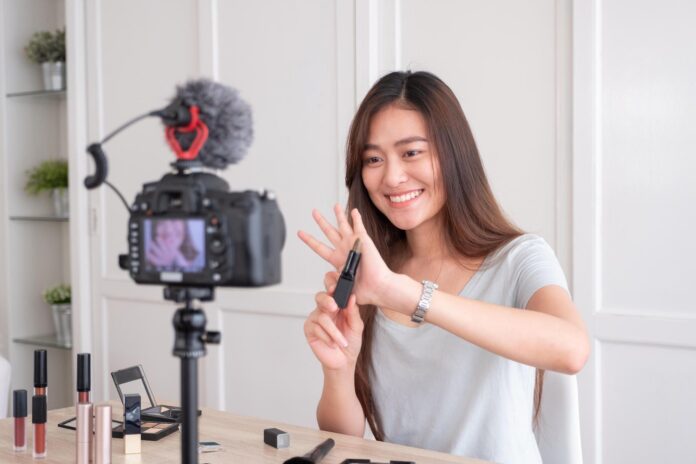Who can become a social media influencer, and how much money can they make for this kind of work in Pakistan? That is the subject of this special report by Profit.
Before the internet age, the bare essentials of becoming a celebrity via an artistic career path – be it through acting, dance, or music – was to be conventionally attractive, very well connected, and have the bare minimum talent required to impress an audience. While the entertainment industry around the world has no doubt produced exceptional content in the form of commercials, live entertainment, movies, and TV shows, the industry has been at risk of stagnation, which is apparent with the trend of rebooting existing content.
In the nearly 40 years since the internet was created, the innovation has largely been used by aspiring artists as a means of democratizing access to tools for content creation, content distribution, and content monetisation – all the while cutting out needless middlemen. Social media apps such as Facebook, Twitter, TikTok, Instagram, and YouTube are among a handful of platforms used in Pakistan by both users and creators, with the latter being both advertisers and those attracting a following through their art.
Of late, this art has manifested itself in covering songs, vlogging about travel experiences, harmless pranks, sharing educational content, offering advice, and even in some cases citizen journalism. The generation that grew up being told – one way or the other – that artistic success in Pakistan is predicated on being a specific sect, religion, or pigmentation – are seeing a superfluity of examples across social media where fame and wealth is a factor of talent and nothing more.

Granted, there are examples of attractiveness and connections playing their role, but the platforms themselves do not create barriers for those deemed unconventionally attractive or without quality networking. It is this disruption that has propelled entire careers into action worldwide, forming the field popularly referred to as influencer marketing whereby social media content creators are a vehicle to sell products and services.
Based on Mediakix data, Business Insider Intelligence said that the influencer marketing industry is on track to be worth up to $15 billion by 2022, up from as much as $8 billion in 2019, adding that Instagram is the gold standard for the media tactic.
Speaking to Profit, a spokesperson from the Digital Engagement Network (DEN) said that advertisers in Pakistan are projected to spend nearly $25 million in 2021 on influencer marketing, touting it as an alternative source of original branded content that has greater engagement than regular commercials. The trend is also in line with the momentum with which advertiser funded projects (AFP) have taken off in Pakistan, primarily led by the entertainment, sports, and partnerships (ESP) team at GroupM, formerly known as Broadmind.
“[GroupM ESP] leverages strategic partnerships and creative expertise to deliver innovative solutions across branded content, product integrations, influencer marketing, activations and events,” said Naveed Asghar, CEO of GroupM Pakistan. “Recent notable examples include: Candy Meray Dost Meray Yaar 2, Nescafe Basement, and Supreme Gharana and many more.”
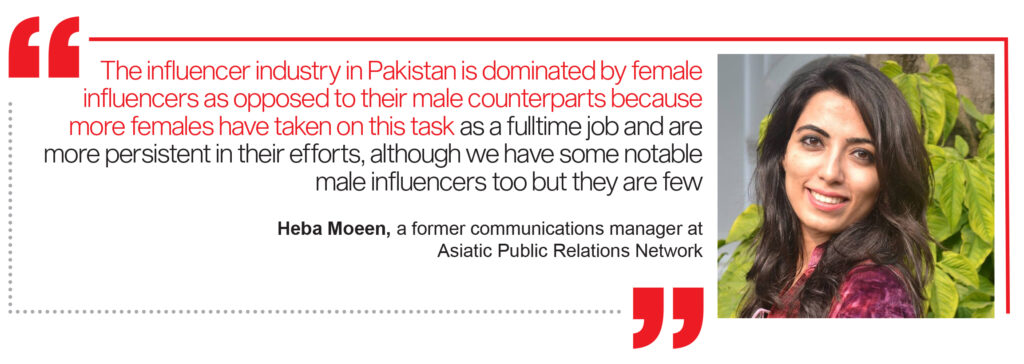
The cast of the aforementioned AFPs consist of up and coming musicians, social media celebrities, and artists made famous by the internet, with the output amplified and published on video platforms such as YouTube and cross distributed with mainstream TV channels as well. For instance, Meray Dost Meray Yaar is a co-production of GroupM ESP and LU Pakistan, distributed on Geo Entertainment and YouTube. The second season was recently renewed and features seamless product integration within the core storyline.
In the United States, the growth by which influencer marketing has taken off – and the subsequent rise in social media content creators using their following to sell products and services – prompted attention from the Federal Trade Commission in the United States, which sought to create guidelines for transparency around product recommendations and endorsements.
While no regulator in Pakistan has drafted nor enforced these rules, spokespersons from digital agencies such as Digitz and Empact Activations told Profit that they instruct the social media content creators they collaborate with to include the hashtag of #spon to inform audiences about the relationship between the creator and the product. In a panel discussion on Karachi Creatives, Dubai-based travel cinematographer Altamash Javed said that influencers need to ensure that audiences are aware of the commercial relationship to maintain trust.
As reported by Profit, by the second quarter of 2020 advertisers in Pakistan shifted a significant and sizable portion of their media budgets to influencer marketing amid the inability to shoot regular commercials amid restrictions created by COVID-19. While creative agencies such as Ishtehari were able to do so for clients such as Unilever, not every agency has the agility or the maturity to follow strict protocols needed for a safe production experience.
Thus, advertisers turned to their digital agencies to create a bridge with social media content creators with an existing production set up for conceptualising, shooting, editing, publishing, and amplifying branded content.
In an effort to understand just how viable the commercial side of influencer marketing is for the social media content creators themselves, Profit collaborated with five leading companies in the public relations, digital media, and technology space to understand the pricing dynamics and earning potential for creators across a range of followers.
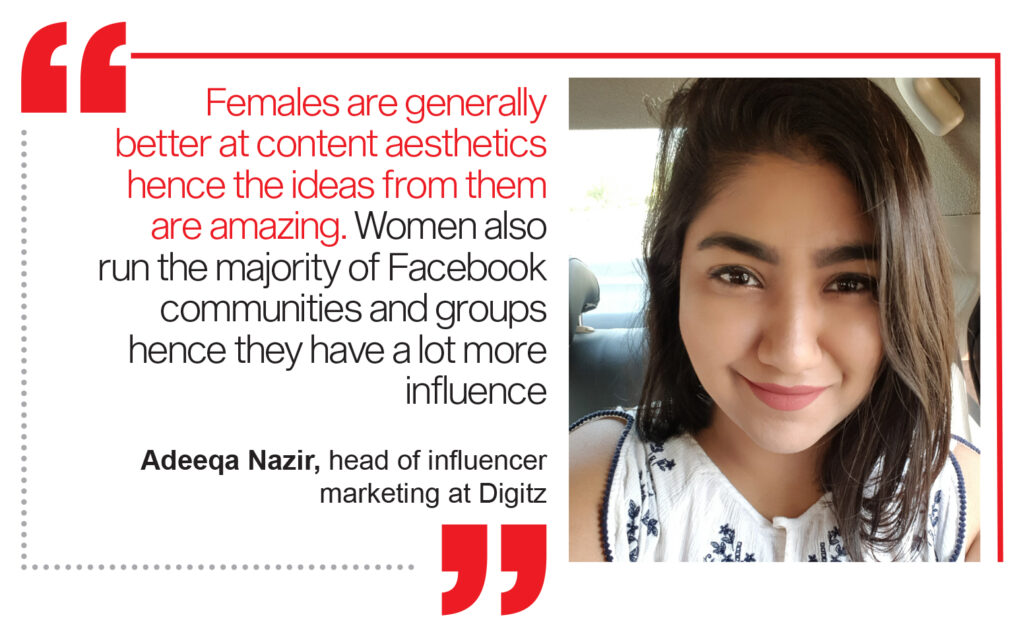
With data representing over ten thousand social media content creators from Digitz, DEN, Walee, and two public relations agencies that requested anonymity, Profit cleaned the data to reach ten key takeaways highlighted below, along with perspectives from practitioners on a deeper perspective on the study outcomes.
The data covered creators classified as nano, micro, power, vlogger, and celebrity influencers, classified by having under 10,000 followers, over 10,000 followers, over 100,000 followers, over 250,000 followers, and over 500,000 followers respectively.
The objective of this pricing report is to empower current social media content creators with a transparent overview of what their peers and industry leaders generate and why. This report is also meant for future social media content creators to understand the above and the potential whitespace to focus on to avoid topic or industry saturation and the subsequent inability to charge high rates due to commoditization: the laws of supply and demand.
Key Takeaway 1: Average pricing in 2020 is 15% higher than 2019.

As more advertisers and agencies experiment with influencer marketing, see results, and invest more, budget allocation rose along with pricing. Coupled with the pandemic, advertisers and agencies relied on social media content creators to amplify their campaigns or in some cases be the campaign in itself.
“The need for influencers grew as influencer marketing took a spotlight for brands who generally didn’t opt for it,” said Adeeqa Nazir, head of influencer marketing at Digitz. “Also, a lot of influencers increase their costs as they hit a certain follower benchmark.”
Speaking to Profit under the condition of anonymity, a public relations agency leader said that some digital agencies will operate as talent agents for social media content creators, being their business managers under the table. By playing both sides – the advertiser and the talent – agencies are able to push the talent to raise pricing while ensuring them of guaranteed partnerships, all the while convincing clients to raise the stakes as well.
While the pricing varied by post type, for videos in 2020, the average price per post went up to Rs212,200, an increase of about 15% from the previous year.
“I think influencers understood their impact and market better,” said Safaa Rauf, founder of Mad Media. “Also the creativity increased which resulted in higher costs of creating content for brands.”
Key Takeaway 2: Celebrities and Vloggers charged 27.5% more in 2020 than in 2019

With the highest follower bracket and the pandemic shifting media consumption habits to social media, as did the following and reach of both vloggers and celebrities such as Amber Javed, Junaid Akram, Mooro, Irfan Junejo, and Fatima Irfan.
“The need for digital content, integrated content, native content increased hence the cost for it as well,” said Nazir. “Production houses couldn’t do full scale DVC/TVC shoots hence, vloggers with their own equipment and great content skills got a lot more work.”
Key Takeaway 3: Millennial (ages 25-34) influencers have the highest average rates

“[Social media content by millennials] is relevant, they cater to a larger audience as majority brands are now targeting millennials,” said Nazir. “These guys also have the highest following and share of voice on digital.”
Speaking to Profit under the condition of anonymity, a public relations agency leader that contributed data for this report said that – frankly speaking – social media content creators over the age of 34 are not good at connecting with younger audiences unless they have existing fame from mainstream media.
“The non celebrity social media content creators are simply terrible at creating content that matches the interests of their intended audience,” she said. “It could be that creators in this age bracket are hard to relate to, create content that audiences don’t care about, or have failed to deliver the bare minimum quality needed to be deemed likeable.”
She said that it is not fair to say advertisers and agencies are ageist or that an algorithm is biased, adding that it is more likely a scenario of not playing to one’s strengths.
Key Takeaway 4: Influencers from Islamabad have the highest average rates

Rauf told Profit that Islamabad was first on the scene when blogging and influencer marketing took off in Pakistan, with the first mover advantage meaning the creators from the capital have a stronger following. She said that, according to her data, content performs better in Punjab, thus when they get a higher reach they can charge more. She added that creators in Islamabad run in similar circles, amplifying each other and maintaining similar rates.
“I don’t think there is a method to this madness,” said Nazir. “Top influencers from Islamabad also have really high following so sometimes the money justifies and sometimes it’s just the rich status that speaks.”
According to internal documents obtained by The Intercept, moderators employed at Bytedance for the TikTok platform were instructed to suppress posts created by users deemed too ugly, poor, or disabled for the platform.
Facebook has been accused of giving suppressed creators vague reasons for why their content doesn’t appear on the explore page, while its Instagram guidelines state that the content will be available on the feed of followers.
Variations of this complaint have also been made against large advertisers which appear to prefer creators that appear to be wealthy or acceptable for mainstream audiences.
Key Takeaway 5: There are three times more female influencers than male
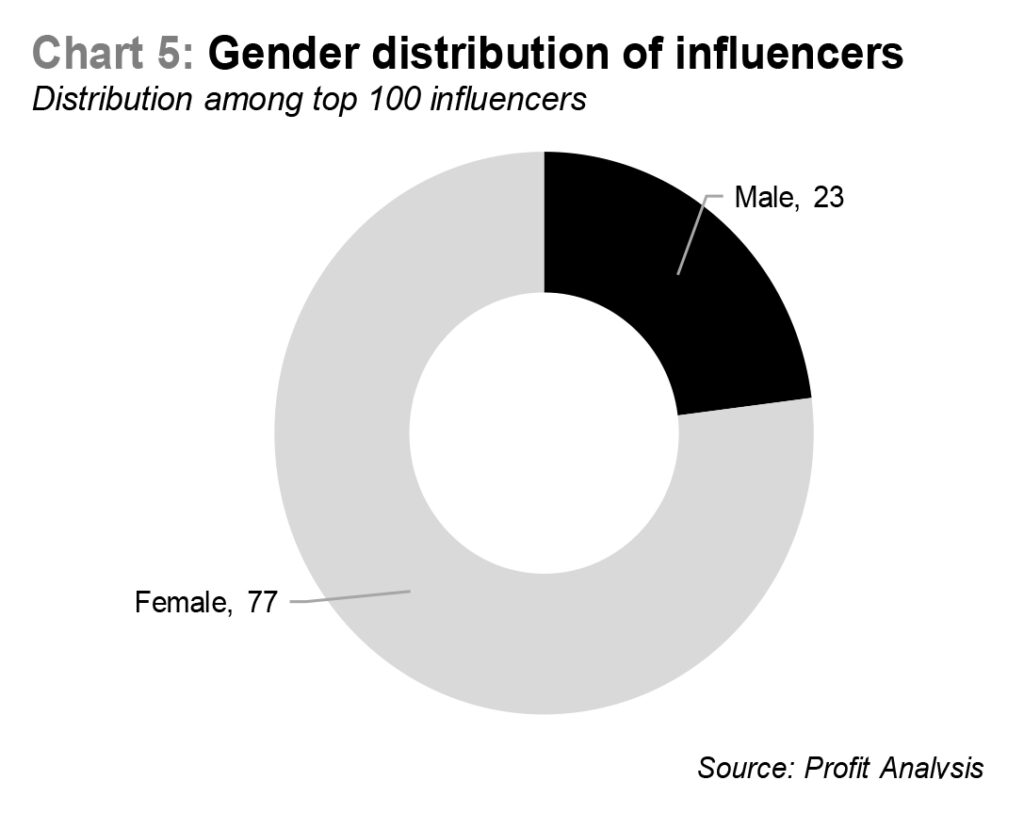
“The influencer industry in Pakistan is dominated by female influencers as opposed to their male counterparts because more females have taken on this task as a fulltime job and are more persistent in their efforts, although we have some notable male influencers too but they are few,” said Heba Moeen, a former communications manager at Asiatic Public Relations Network.
Speaking to Profit under the condition of anonymity, a public relations agency leader said that given the lack of expectation in Pakistan to be breadwinners, they are more free to pursue alternative passions, with the local culture embracing any self-appointed roles which can be done within the comfort and safety of their own homes.
“Females are generally better at content aesthetics hence the ideas from them are amazing,” said Nazir. “Women also run the majority of Facebook communities and groups hence they have a lot more influence. Men generally are great at street content vlogs so you’d see Irfan Junejo, Mooroo, Danish Ali doing great at all this but when it comes to lifestyle, fashion, food, women lead it.”
Rauf told Profit that the audience on Instagram has a similar male to female ratio in Pakistan, adding that since most of the work is around fashion and beauty, most of the work is stereotypically awarded to women.
“Most brands that are advertising want to advertise a product for females, through females,” said Rauf. “Also since male influencers don’t grow so rapidly they don’t get to charge as much as females who have a higher following. If we are talking about the same number of followers for male or female, the person with higher engagement will get paid more given the campaign is for both the genders.”
In an earlier interview with Profit, a spokesperson from DEN shared that marketers who think using a female influencer to create awareness about a female-oriented product is viable are mistaken, adding that the data shows that men are the primary followers of female influencers and vice versa.
He added that this is evident even from the comments section, a reality ignored by gut-led and non data-led digital agencies in Pakistan because this reflects poorly on their planning skills and forces them to think of creative ways to reach the target audience. So the matter is swept under a rug.
Key Takeaway 6: Female and male creators dominate topics that fit the stereotype

The top three topics for female influencers are: beauty, fashion, and parenting, while the top three topics for male influencers are technology, music, and lifestyle, with both representing an equal footing in the topic of cooking and food reviews.
“Women tend to talk about topics that come naturally to them, for example beauty and fashion, meanwhile travel is a niche segment which few talk about and then this line is also blurred by lifestyle influencers,” said Moeen.”
The data showed that female social media content creators have saturated the beauty, fashion, and parenting space which has impacted their ability to profitably price their services, while male social media content creators have done the same for technology, music, and lifestyle.
The whitespace for aspirants in the influencer space is to capture an audience around a unique topic, with women facing low competition in technology, music, and lifestyle, while men have an opportunity to capture a slice of the parenting, fashion, and fitness space.
“This industry is still in its developing stage and a line has to be drawn between let’s say seeders and influencers, between mere following numbers and good engagement through quality content creation, and influencers having found their niche rather than talking about anything and everything at all,” said Moeen.
Key Takeaway 7: Female influencers made twice as much as male influencers

The data showed that on average, female influencers made nearly twice as much than male influencers, with variances occurring once comparisons were made at higher follower content levels and fame levels.
“[Female content creators are] just make 100% better content, have 100% better reach and are super easy to work with,” said Nazir. “But also, Mooroo, Irfan and a lot of other vloggers make 100% more money than female vloggers.”
Female influencers earned on average Rs. 2.5 million, Rs 2.27 million, and Rs. 2.066 million in 2020, 2019, and 2018, while male influencers earned an average Rs. 1.26 million, Rs. 1.159 million, and Rs. 1.059 million during the corresponding period.
As evident from the other data points, this has to do with the first-mover advantage in the influencer space, with industry experts sharing that female social media content creators in the beauty, fashion, food, cooking, and parenting topic space were among the top choices by marketers and agencies experimenting with sponsored posts and videos.
“Advertisers in Pakistan tend to conflate influencer marketing with brand ambassadorship, so you will see instances of an influencer such as Faiza Saleem being used in a campaign independent of her social media following,” said a public relations practitioner who spoke to Profit under the condition of anonymity. “Look at any random billboard in Pakistan, it has a woman on it. Women are used to sell products and female content creators offer themselves up to be used as a vehicle for grabbing eyeballs. There are simply more opportunities for them.”
Key Takeaway 8: At peak COVID-19, rates for travel influencers fell 15%.
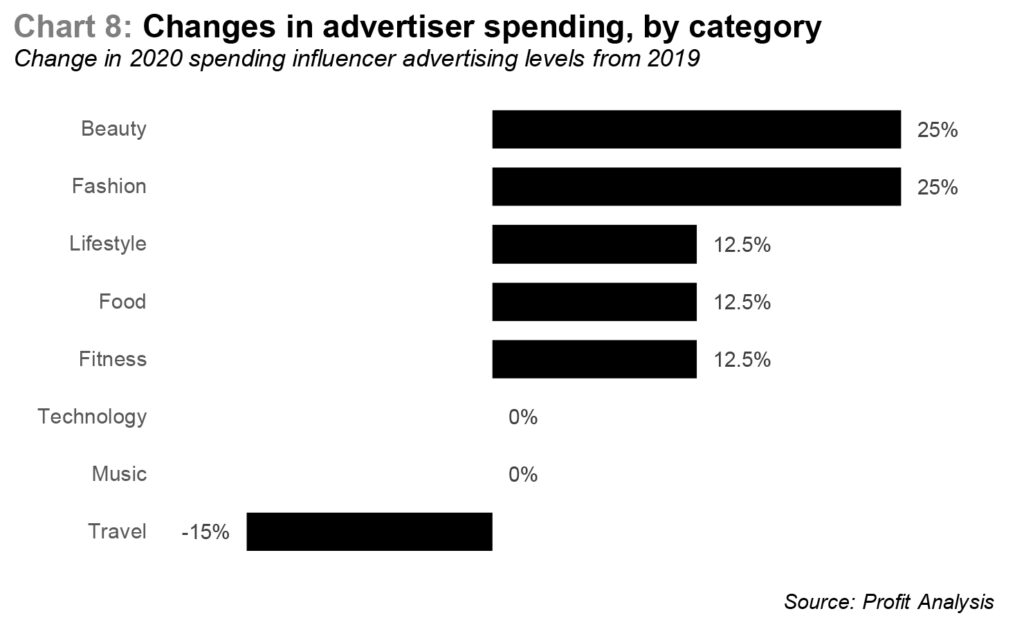
The data showed that by Q2 2020, travel social media content creators not only lowered their rates but diversified the content they created, while social media content creators in other categories increased their rates particularly around products or categories where demand was relatively unaffected by the pandemic.
“There is no travel, hence there is no content,” said Nazir. “There’s only so much nostalgia you can promote on your feed.”
Key Takeaway 9: Influencer marketing performs better when part of an integrated campaign
Based on data provided for five prominent influencer marketing campaigns, such as Anday Wala Burger by McDonald’s featuring Ali Gul Pir and the 11/11 sale by Gul Ahmed featuring Faiza Saleem, the data showed that integrated campaigns outperformed silos.
When marketers used influencer marketing as one of their media tactics as part of a larger integrated marketing communications plan, the return on marketing investment (ROMI) was 11.7 times higher than the aggregate cost of media investment on products at a discounted price and 9.3 times higher on products at full price.
When social media content creators were the only tactic for a campaign, the return on marketing investment (ROMI) was three times higher than the aggregate cost of media investment on products at a discounted price and 1.1 times higher on products at full price.
“Influencer marketing is still growing hence when paired with an integrated marketing communications plan, the collective results are bigger and impactful,” said Nazir. “However, ROI for sales via influencer marketing is still being explored and should maybe lead towards affiliate marketing to actually see results in terms of sales.”
The aforementioned examples regarding McDonald’s and Gul Ahmed, for instance, were amplified with out of home billboards, DVCs, paid social media, radio, and more to acquire a deeper share of voice and create higher brand recall.
“The more effective the influencer plans are, the higher the impressions which result in higher awareness and better recall,” said Rauf. “Having a standalone influencer plan works out great for smaller to medium sized business however large scale businesses should definitely have a more 360 strategy in which influencer marketing plays a substantial role.”
Key Takeaway 10: Engagement rates decline with higher followers.
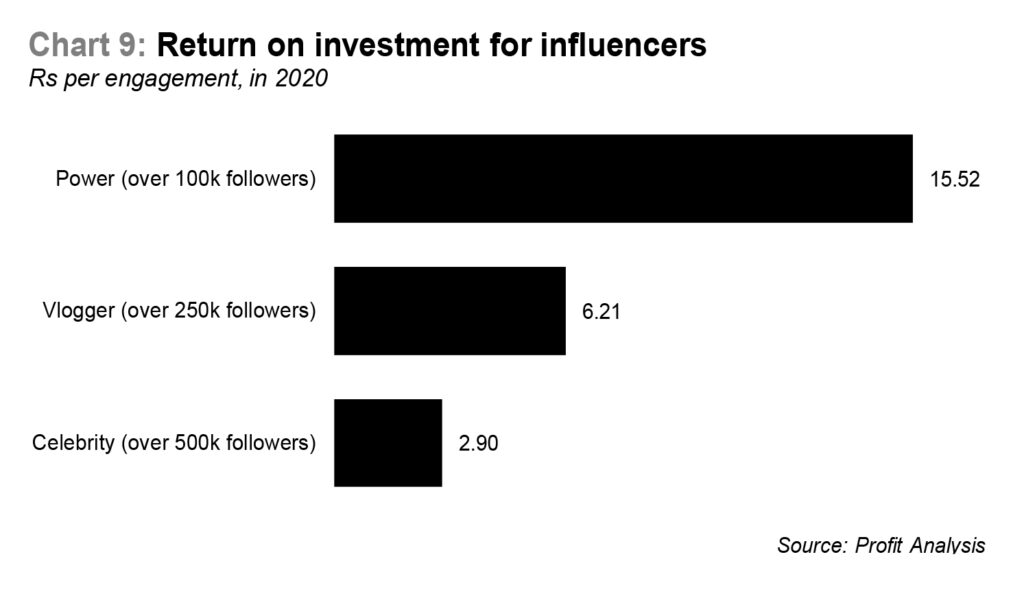
The average campaign engagement rate per influencer type across power, vlogger, and celebrity creators was 5%, 3.75%, and 1.25% respectively.
“There are multiple [reasons] to this, the [top two being] fake followers [and] the platform,” said Nazir. “Facebook and Instagram really cut down the reach for bigger profiles because they do want them to spend money to reach the audience.”
Speaking to the laws of diminishing returns, Nazir told Profit that nano and micro content creators are relatively new or small profiles and can reach 15% of their audience without paid media.
“I have 2000+ followers and on average my story gets 800 views which is like 40% engagement but then again the number of people following me is too less,” she said.
Moeen told Profit that advertisers in Pakistan still struggle to grasp the fundamentals of digital as a means of reaching audiences, much less so the tactic of influencers led advertising, with issues such as follower fraud and weak engagement cast aside for quantitative factors.
“Also, there is a growing trend of buying followers on social media platforms; brands that engage with influencers only on the basis of massive following need to check the engagement rates as well and whether the influencer’s overall content resonates with the brand image,” she said. “Relevance and engagement are of utmost importance.”

















